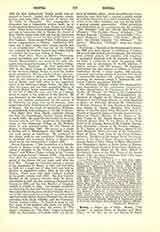

Bostra, a titular see of Syria. Bostra, “The fortress”, is neither Bosor of Reuben and Moab (Deut., iv, 24; Jos., xx, 8), nor Bosrah of Edom (Gen., xxxvi, 33; Jer., xlix, 13, etc.), now Bouseira between Tafile and Shobaq. Perhaps it is the same as Bosor, or Bosora, taken by the Machabees (I Mach., v, 26, 28, 36), an independent town in Peru. It was included in the Nabatean Kingdom (M. de Vogue, La Syrie centrale, Inscriptions, 103) and last held by the Romans. When the kingdom was destroyed by Cornelius Palma (105 or 106), a general of Trajan, Rostra became the metropolis of Arabia and was known as Nova Trajana Bostra. There the Third Legio Cyrenaica held its garrison. In the same year began the era of Bostra, after which the numerous inscriptions in trans-Jordanic Palestine are reckoned. The city was already a very important one; it was there that the great Roman road began which ran to the Red Sea, as well as most of the other roads that crossed the country in every direction; the governor of the province had his residence there.
Under Alexander Severus (222-235) Bostra became a Roman colony. In the fourth century it is called “a great city”, by Ammianus Marcellinus (Res gesti, XIV, 8, 3), and from the extent of its ruins G. Rindfleisch has calculated that it must have had about 80,000 inhabitants (Zeitschrift des deutschen Palastinavereins, xxi, 32). Remains of splendid monuments are yet visible, colonnades, triumphal arches, baths, a theatre, temples, churches, etc. Bostra, being an important trade center for caravans, was visited by Mahomet; it was there that Bahira, a Nestorian monk, acknowledged him as a prophet. The Crusaders tried vainly to take it. Its decline was the result of earthquakes, chiefly that of 1151, when the city was left in ruins. Under its present name of Bosra Eski-Sham (Bostra Old Damascus), it has hardly 1000 wretched inhabitants and a little Turkish garrison.
The Christian religion, which soon penetrated the neighboring Arabia, was not long in reaching Bostra. As metropolis of the province of Arabia it had nineteen or twenty suffragan sees. Lequien (Or. Chr., II, 853-860) enumerates a list of sixteen bishops at Bostra; among the most celebrated are Beryllus, who fell into a Christologic heresy and was reclaimed by Origen at a council held between A.D. 218 and 244 (Euseb., H. E., vi, 33); Titus, who suffered much under Julian the Apostate, and who was an important writer, J. Sickenberger devoting a long essay to him (Titus von Bostra, Leipzig, 1901); St. Antipater, about 458; Stephen, at the beginning of the eighth century; and Arsenius, who lived in 1365 (Miklosich and Muller, Acta patriarch. C. P., I, 465). The diocese existed till 1715 (Chrysanthus, Synodicon, 70). Subsequent to that it was suppressed by the Greeks, and its 6000 faithful are subjects of the Diocese of Damascus. The Catholic Greeks, or Melchites, however, have always maintained this see, under the title of Bostra and Hauran. Their metropolitan resides usually at Damascus and goes to Bostra only two or three times a year; his diocese contains about 8000 Catholics, 12 priests, and 12 parishes. The Crusaders by a mistake ranked Bostra under the authority of the Patriarchate of Jerusalem, instead of under that of Antioch.
S. VAILHE

